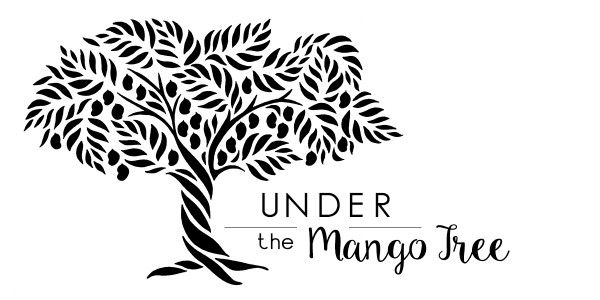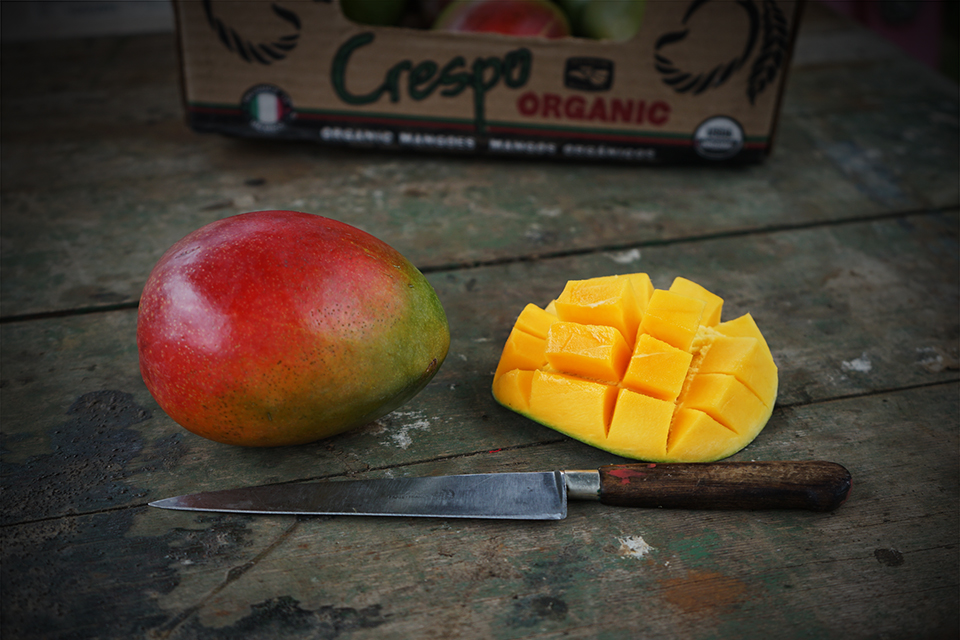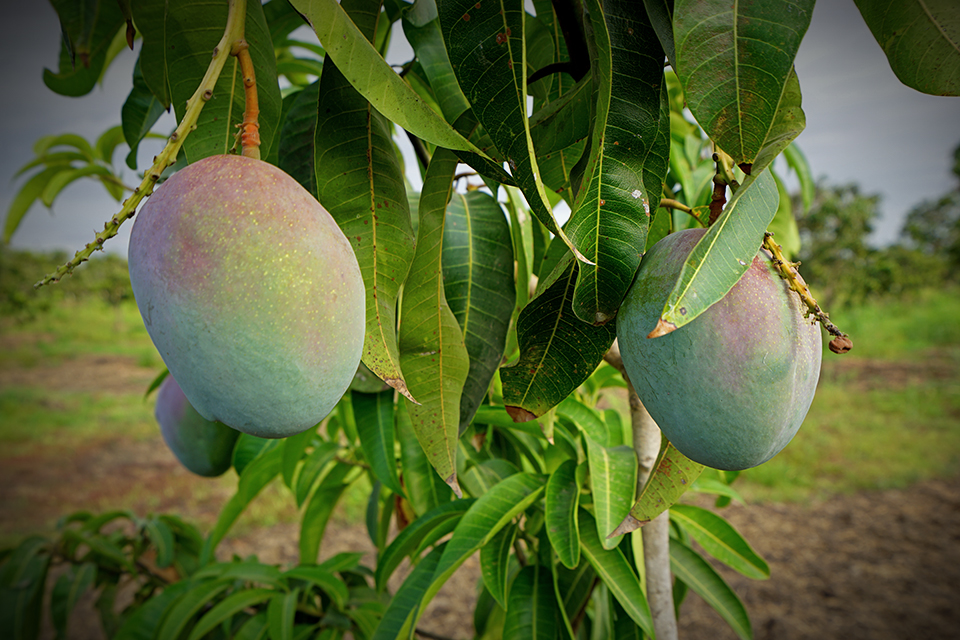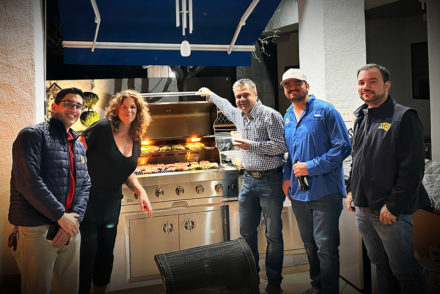A deep dive into the when’s, why’s and how’s of the firm fleshed, farmer friendly mango
My favorite mango is a Tommy Atkins, but it’s not because it’s farmer and supply chain friendly. It’s my favorite because it’s culinarily versatile and it also happens to be farmer and supply chain friendly which isn’t a bad thing.
If you google Tommy Atkins, one of the first links is Wikipedia which describes in the first sentence the Tommy as not generally considered the best in terms of sweetness and flavor. If you ask me, this sets up Tommy for a negative bias before you’ve even seen one in real life. Yes, the statement that follows is true, basically saying: it’s grown because it fares well in the production and import supply chain. But, for real, this is a gigantic part of the equation, in all parts of the world, for all commodities. Not unique to Tommy.
Before you hear the retort from an adoring Tommy Atkins fan, based on my professional mango expertise and observations, not to mention my culinary exploits, I want to report that we have harvested the first organic Tommy Atkins from El Grupo Crespo’s southern orchards and, as this glides into your inbox, our southern packhouses are cleaning, polishing, and packing them into several of our most coveted packaging SKU’s: the Crespo Big Box, Net Bags and the old faithful Crespo 4KG case (all of which have been designed to look dashing as both big and small mango displays while also proving strong as stand-alone displays and storage).
Predictability Tastes Good to Farmers; That’s Important
Okay, so technically the Haden is my favorite mango, as I enjoy its sultry perfumed quality in the same way I am attracted to a really good heirloom pear or melon. (And note, my deviation here will come back around, so stay with me.) I have an aversion to very sweet things, so some of the sweeter global varietals like the Alphonso, Nam Dok Mai, and even the Ataulfo can be way too sweet as an eating mango for me. This explains how and why I came to use them in my culinary recipes (yes, I cook and write recipes professionally, too). I like using mangoes as not just a natural sweetener, but as a flavor and you would be surprised how varied you can make mango flavor taste.
A Haden is a cross between a Mulgoba (which some say is the best tasting mango in the world despite its ugliness) and a turpentine or jungle mango which tastes like turpentine when eaten green but like tropical magic when tree ripened. They were brought to Florida by way of Cuba and are still the predominant root stock of most Floridian mango trees. I would imagine, I need to find out, that what the Mexicans refer to as the criollo mango is a similar version of this and which is also used as rootstock on most commercial trees there (and they taste amazing)!
The {larger} rise of the commercialization of mangoes only really started during the 80s, making this an incredibly young industry. Haden’s tend to be small (really small) and susceptible to a lot of quality issues. Haden’s were a popular commercial mango originally and were grown all around the world, but eventually they proved difficult for production (fungus), hot water treatment (which started in 1987) transport and shelf life. The Tommy Atkins mango production replaced most of the Haden’s in the commercial sector. Tommy’s production expanded, especially for countries exporting to the USA, and I’d argue this expansion and the rise of Ataulfo production is directly correlated to the rise of US consumer mango consumption. Mango consumption in the US, as many of you know, has trailed significantly in comparison to the rest of the world. The Tommy Atkins paved the way for better price points for consumers and more profitability for farmers, this helped drive mango consumption.
It’s my opinion that now that the industry has great momentum and created lots of new mango eaters that we have a responsibility to expand varietal choices, which is why I feel great pride in the Crespo siblings for being so forward-thinking with their specialty varietal orchards, plans, and executions. Varietal wise, there is no doubt the mango landscape of the US will look different in the future, but I think the Tommy Atkins will always be a staple and for good reason.
Now, I just happen to be sitting here snow birding in the only place in the contiguous USA where mangoes thrive naturally (aka southern Florida). This seems fitting considering that the Tommy Atkins mango was discovered right up the road from me in Ft. Lauderdale. Coincidentally, it’s said to have grown from a Haden seed on the property of Thomas H. Atkins. As the story goes, Thomas had really tried to get this new varietal noticed since the 1950’s but no one cared: its fibrous nature and what they called “unremarkable” flavor deterred all interest. But Mr. Atkins believed in this fruit for commercial production and, as commercial production in Florida grew, problems in commercial production rose and the interest in the Tommy Atkins mango did, as well.
Eventually most of the commercial plantings in Florida were Tommy Atkins and, lo and behold, the sunshine state excelled in the commercialization of mangoes. As demand grew, commercialization expanded into Mexico and South America. Haden, Kent, Keitt and Tommy Atkins were the main varietals. All of these have in common that they are Florida-discovered varietals planted in Latin America. As Florida’s mango commercialization declined, Latin America’s grew.
The fact that costs were cheaper does not singularly explain the shift in production to Latin America. Southern Florida urbanization, rising land costs, climate change bringing more powerful and more frequent hurricanes and frosts were all part of the drivers pushing more mango production into Latin America. Eventually Latin American producers learned what Floridians knew: the Tommy Atkins mango fared very well in commercial production and yielded far better results in the longer supply chain which equated to actual profits. Let’s not forget these are important and deserved. The Tommy Atkin became and still is the most planted varietal in Latin America today.
Mild Flavor and Fiber Have Advantages
The Tommy Atkins mango is not just a mango that fares well in the complex and abusive supply chain we have created, but I also think it’s a solid eating and culinary mango that is not to be overlooked despite its fiber and mild flavor. In a way, it’s the best all-around mango we have. It is versatile and mild enough for beginner mango eaters, and it offers just enough tropical flare for the advanced mango palettes. Each and every mango offers a unique experience and, like people, when we get to know the positive aspects of each, we find more joy in the eating experience (what I call #MangoJoy, which is a real and powerful thing, proven by the fat that mangoes are the most consumed fruit in the world).
The Tommy Atkin has the mildest flavor of all the imported mangoes. It’s sweet but not overly sweet, which is why it’s one of my favorite varietals. While nothing in the flavor is all that striking, they do taste like mangoes the way most roma or cherry tomatoes we buy taste like tomatoes. If you are looking to replicate the eating experience and flavor of the mangoes you ate while in Asia or India, this won’t do it for you. But you can still have a worthwhile eating and cooking experience. Of all the rounded imports, they are probably the least bitter tasting when green, and a lot of people enjoy them green with or without lime, chili, or salt.
These oval shaped mangoes that come in a vast array of sizes have firm fibrous flesh. They are the least juicy of all the imported varietals and their fiber is one of the biggest complaints mango lovers have about them. Yes, it’s true and logical that the fiber is also what makes them fare better in the water bath and long supply chains and that’s what most people focus on. But if you are like me and cook with them a lot, you may have a different opinion; you might think the firm flesh makes them excellent chopped and cubed, holding their shape better than any other varietal and still adding vibrant tropical flavor to whatever you use them in.
For me, there is no better Pico de Gallo mango than the Tommy Atkins. A good pico de gallo (which translates to little bits the chicken eats) will fly away in the wind when tossed up in the air, which means everything needs to be chopped into tiny pieces and not create too much moisture. Any chunky mango salsa is perfect with a Tommy. They can also hold their own in a salad when fully ripe; no other mango can do that, and I think that is amazing about them. Drinks, baked goods and odds and ends: this mango can do it all. I’ve created a lot of recipes using the Tommy Atkins mango because, like most consumers, that is what is most often available. I find the firm flesh makes a better upside-down mango cake and holds its cubed cuts more when topped onto my panna cotta recipe and for those fans of the mango rose (I’m not but lots exist), there is no better mango, which kind of makes the Tommy the ideal Instagram mango, which only adds to its prowess, as superficial as that use may be. It also highlights the complexity of today’s consumer demand.
Mango lovers know Tommy Atkins mangoes are as beautiful as they are delicious and useful. They are red and green with hints of yellow, gold and orange undertones that expand as the fruit ripens. Their blush tones are the most beautiful if you ask me. They look gorgeous on display and, yes, they fare better in the system. Few in the industry are educating consumers about what exactly “the system is”, and I happen to think it’s important that consumers know why we do what we do, what the stories are behind it. I happen to believe that the more we are transparent about the problems, the easier solutions are to find. There are more varietals available today than ever before I, along with the Crespo’s wants to continue to lead the industry down that path which includes offering more varietals and that means (where I come in) educating consumers and general produce industry to be commodity and culinary experts from orchard to table! Information is easy to share these days and it makes a big difference.
A Secret Bathing Ritual and Best Industry Supporting Mango
There is little information out there for consumers when it comes to the How’s & Why’s of produce systems. In my experience very few consumers understand the “supply chain” and what that really means per commodity, mostly these systems have been hidden from them. I do my best to lift the curtain as I believe an educated industry and consumer base is better for us all, especially consumers and farmers. The import process, in particular the USDA regulations surrounding the import of fruits and vegetables, is something Americans are rarely given access to. The average American has no idea that we can’t just bring any mango into the country (some Americans have never even seen or tasted a mango) and that all of the imported mangoes have to go through some sort of treatment prior to arrival in order to ensure eradication of the fruit fly. For all Latin American imported mangoes, this means The Secret Bathing Ritual aka the Hot Water Bath.
For other commodities and (also some mangoes) fumigation and irradiation are big treatments, all of which are not permitted in the organic system. We have only the hot water bath, and all imported mangoes depending on size have to be dipped in this HOT bath for anywhere between 90-120 minutes and, once removed, not allowed to be air chilled immediately. Mango folks have it tough, and the Tommy Atkins has proven a handy tool in the growth and learning curve on how to bring better mangoes to consumers. The Floridians in their peak commercial days knew the Tommy’s strength, and they didn’t even have to use a hot water bath.
Size Matters
Another important aspect of producing farmer friendly mango varietals is the size. I guess I should be clear on what I mean by farmer friendly, I mean specifically varietals that they can make money selling, that aspect is crucial. I have a saying than I have been saying since I was a baby in this business, ” if the consumer is satisfied with quality, price and flavor and the farmer is able to make money producing it, time and time again, than it is a viable produce item for all of us.” More often than not sizing matters at retail level, that is not to say that off sizes are “difficult” to sell, it takes a lot of work but that is the job we in sales have and all the wonky imperfect sellers, didn’t really create anything new in their models, they are not saving the planet and eliminating food waste, they saw the void that the” middle man/brokerage sector of the business that tends to have less risk and teds to take less responsibility for finding homes for off sizes, despite the fact that they exist and pounced on it. This is one of the reasons I believe more producers should focus on a more direct trade style of selling, gaining more power to move clear information and all product from orchard to table, thats what sells off sizes and strong partnerships with the wholesalers, processors and retailers. Sometimes that means changing varietals, the same as we want to add new ones for flavor, we want them for size.
Remember my favorite mango, the Haden, the one thats fading more and more in Mexico? Haden trees often produce small mangoes in the sectors they are grown, I don’t know much about how they grow in Florida or Australia but in Mexico trees yield small mangoes- like really small, A LOT 14cnts and thats not conducive to what the market wants or needs. Is it a good mango, yes but it doesn’t make sense for many Mexican farmers who will have to sell the small sizes, which is the majority of the crop often for cheap and sometimes at a loss. Tommy’s yield a vast array of sizes regardless of the season in terms of a big size or small size crop. They still tend to produce a plethora of retail supportive sizing, in all regions of Mexico. Which reminds me to mention that these days, with climate change varietals are less and less predictable not just in the context of the larger regions and subregions but even in the micro orchards. It’s not easy to gauge what will happen as much as it used to be. Some varietals start early ( Ataulfo- Early and long) and some late ( Keitts- short and late), some long and steady (Tommy). We all live in that realm, climate change times and these mango communities in Mexico, these mango farmers, need to make money to exist and so again the steady & stable Tommy Atkins mango is important to their success; our industries success.
Stable & Diverse: Balance Builds
As the industry advances, we inch closer to the diverse mango offerings we all crave. But it takes a lot of trial and error and also significant risk, aka economic investment. We have committed to this in our Crespo system and created success with the Thai Sweet Green Mango and the growing interest in the Mallika and the Nam Dok Mai with strong wholesale and retail partnerships driving this forward, and mango consumers hungry for how they can help. I cannot stress the importance of strong partnerships in the quest for varietal advancement. It starts with the farmers and people like Jorge Crespo aka The Crespo Mango Man, who lives and breathes mango diversity as demonstrated by his secret orchards and his chat history with people in places like Pakistan, India, Dominican Republic and Florida. But the mix also needs retailers and wholesalers who have their hands closer to consumers; partners that also put in risk. And the last part of the equation is the consumer who we can ideally reach and educate on the process of “perfection”. We need consumers to be a bit forgiving sometimes, especially with new things. It’s all of us in it together. And when we do work together the diverse mango world that I envision has room for lots of different mangoes. The Tommy Atkins is one of them.
The Tommy Atkins is not a bad mango for anyone, that is the truth.
















No Comments